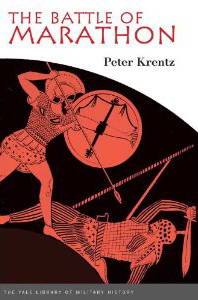 |
||
|
Review of The Battle of Marathon by Peter Krentz |
||
|
Peter Krentz, The Battle of Marathon (Yale Library of Military History) Hardcover, 230 pages Published September 7th 2010 by Yale University Press ISBN-10: 0300120850 ISBN-13: 978-0300120851 Reviewed by John Trikeriotis, member of the archaeological group ‘The Leonidas Expeditions’ |
|
|
When the word Marathon is mentioned, it usually conjures up images of today’s athletes running in one of sport’s ultimate tests of endurance. Its genesis, however, can be traced back around 2500 years ago to 490 B.C., where legend has it, a herald ran approximately 26 miles from the battlefield of Marathon to the city of Athens. Upon entering what would eventually become the cultural center of Western civilization, the messenger Pheidippides, proclaimed victory by the Greek army over the invading Persian forces, collapsed and died shortly thereafter. While the veracity of this story has been questioned, it is another run associated with the battle that many scholars have also disputed. It's the ‘charge’ by 10,000 - 11,000 Athenian and Plataean hoplites over a distance of around a mile which has met with incredulity from academia. The primary reason for this skepticism is that the Greek hoplite, defined as a heavily armed warrior, wore armor that weighed about 70 pounds. How they were able to ‘run’ this distance in their panoplies (a full set of armor) while rendering the hail of arrows from perhaps as many as 20,000 - 30,000 Persian archers/infantrymen ineffective is the crux of Professor Peter Krentz’s book entitled, The Battle of Marathon. The primary source of this battle has been the historian Herodotus of Halicarnassus, who recorded through oral testimony, that the distance run during this Greek offensive was 8 eight stadia (.9 miles). Since the length of the ‘charge’ has been vigorously debated amongst academics, Mr. Krentz, through analysis and reconstruction has determined that it was feasible. His argument has some validity since he asserts that the Greeks wore armor as light as 30 pounds. This is considerably less than the conventionally accepted 70 pounds of armor, which is what would have comprised about half of the typical warrior’s weight during the era of the Greco-Persian Wars. It is also his contention that since the Greeks worked in an agrarian society, they would have had enough energy to run this distance and sufficient reserve to effectively engage the Persians. |
||
Since the topography of the battlefield has changed and since very few archaeological artifacts have been recovered from Marathon, what Mr. Krentz has described may be deemed speculative. However, what cannot be repudiated and which is reinforced throughout the author’s book is that this landmark victory pierced the Persian aura of indestructibility. The ratio of 32-1 killed supports this conclusion as the losses suffered by King Darius the Great’s army numbered 6400, while Greek losses amounted to approximately 200. |
||
|
While the Battle of Marathon inspired the race which evolved into the signature event of the modern day Olympics, its magnitude has transcended the arena of sports. Englishman John Stuart Mills wrote that: ". . . the Battle of Marathon even as an event in British history, is more important than the Battle of Hastings". Furthermore, Scottish historian, George Finlay stated in reference to Marathon: "There is no battle in ancient or modern times more deserving of praise for its military conduct, none more worthy of admiration for its immediate results on society, or more beneficial in its permanent influence on the fate of mankind." These approbations and others over the last several centuries continually reflect upon the importance of the first major land battle between Western and Eastern civilizations.
One of Marathon’s more renowned combatants, the ancient Greek playwright Aeschylus, who ultimately was recognized as the ‘Father of Tragedy’ purportedly composed his own epitaph. An indication of the battle’s significance is that he did not mention any of the great works in his distinguished oeuvre, only of his exploits on this highly venerated battlefield.
As with Aeschylus’ epigraph and the gravestones, columns and monuments which were erected shortly thereafter, they all attest to the battle’s immediate impact. However, the actions on that summer day on the plains of Marathon between two great civilizations still resonate 2,500 years later and will continue to do so with the 26-mile race which commemorates the mythical run of Pheidippides. |
||
|
(Posting date 12 January 2011) HCS encourages readers to view other articles and releases in our permanent, extensive archives at the URL http://www.helleniccomserve.com/contents.html. |
||
|
||
|
2000 © Hellenic Communication Service, L.L.C. All Rights Reserved.
http://www.HellenicComServe.com |
||

